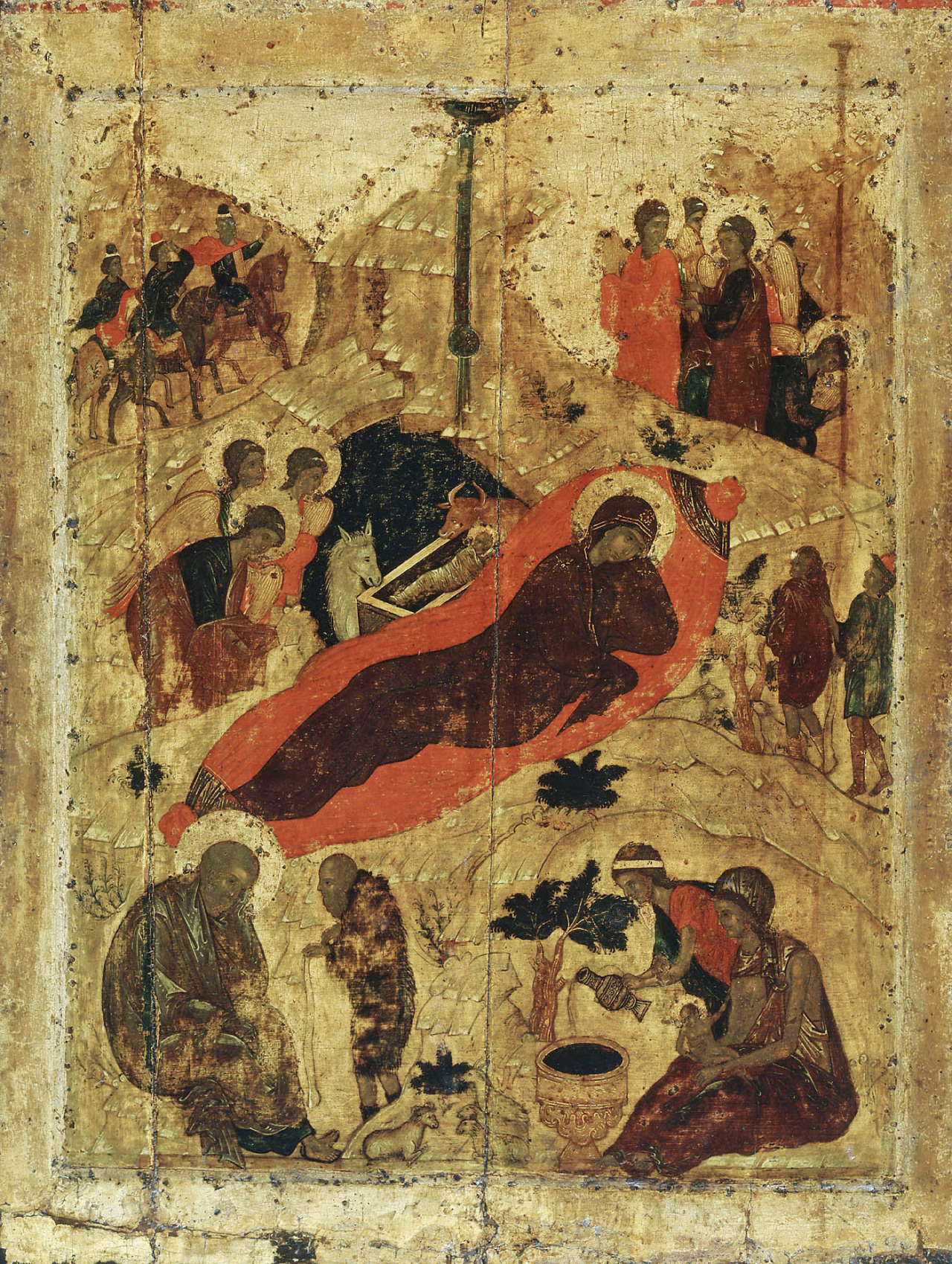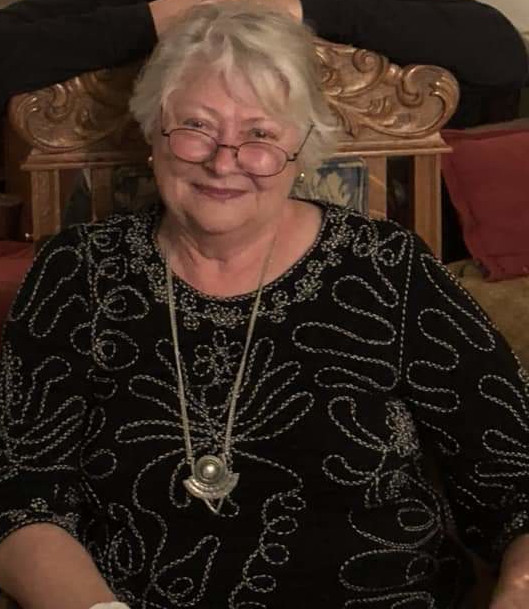
From the time I was a little girl, I loved the beauty that filled our church. Icons with their golden halos shimmered on the walls. The analoi were covered in rich brocades, or embroideries. Priests and deacons, richly dressed, intoned in tune with the choir. Everything was filled with color, harmonious sound, shimmering candles, and delicious scent. The deacon intoned in his deep voice and the bells on the sensor jingled as he glided around the church sending puffs of fragrant smoke up against the walls, and the people, There, in the middle of the church, was the most important icon of all, richly decorated with flowers and brightly lit candles. The icon of the Feast, that tells us what today is about, takes center place.
Christmas is coming, and, as we prepare for this mid-winter feast, that is both joyful and very peaceful, I’d like to examine the Nativity icon, and share the wonderful language of iconography.
Above, we have an image of the Icon of the Nativity that was originally painted by Andrei Rublev, the greatest iconographer of Russia, who lived at the end of the 14th century and the beginning of the 15th. As all icons, it contains the language of the Church easily read by the faithful, for whom these icons were written.
When we consider these holy images, we need to keep in mind that they always refer either to scripture or to liturgical texts and express a visual version of the written word. Moreover, the composition, the colors and the content point us into the deeper theological and spiritual thoughts of our faith. The language of icons works in our minds by the connection of memories or thoughts. When we see something curious, we must try to remember what that makes us think about in scripture or hymnography.
This icon has a circular composition. The center of the icon, and the main focus, are the Theotokos with the child Jesus, who is wrapped in swaddling clothes and lying the manger in a cave. An ox and a donkey look on. That, of course, is the main event that is described in the Gospel of St. Luke: “…the time came for the baby to be born, and she gave birth to her firstborn son and wrapped him in bands of cloth, and laid him in a manger because there was no place for them in the inn.” (`NRSV, Lk 2:7) The Theotokos is lying down, having just given birth, as a regular human woman needing to rest. Looking closely at the child, however, there is an interesting allusion to the future. The Baby is wrapped in swaddling clothes that remind one of grave cloth, the manger is reminiscent of a small coffin and the cave references the cave in which Jesus was laid to rest after the crucifixion. So, the image immediately reminds the viewer that Jesus was born specifically to die for humanity’s sins. The depiction of His birth is an announcement to all of us that his being born is a cosmic event (witnessed by the heavenly powers and kings and local shepherds and the power of the Holy Spirit of God shining down from heaven.)
Why is there always an ox and a donkey in icons of the nativity? That is again a scriptural reference to (Isaiah 1:3) “The ox knows its owner and, the donkey its master’s crib.” (NRV Bible) And that prophecy refers to Israel as a rebellious people who do not recognize the birth of Jesus as the work of God in saving his people. We begin to realize how rich is the language of icons, and that the viewer must look closely and remember what they know of scripture.
Surrounding the central statement of the feast is a virtual whirlpool of figures and activity. Angels sing in the heavens to the shepherds, “Glory to God in the highest, and on earth peace among those whom he favors!” (NRSV, 2:14) An Angel gives the good news to shepherds telling them that this day is born “a Savior, who is the Messiah, the Lord.” (NRSV 2:11)
To the viewer’s left (the “north side") in the middle range of the icon, below the Angels, we see the three wise men hurrying to worship the newborn King, and below that in the lowest corner to the viewer’s left sits Joseph faced by a crooked shepherd representing “temptation” as we read in St. Matthew’s Gospel (1: 19-20). Moving across to the other side, we see the midwives bathing Jesus, as one would bathe a newborn human baby. However, looking closely at the water in the font, it reminds us of the water in which Jesus was to be baptized as an adult. In some icons that relationship is made even more clearly. And so, the viewer brings his eye up the right ("southern") side of the icon, past the little shepherd worshiping at the foot of the cave, back up into the heavens, where right in the very center of the heavenly realm we see the light of the “star,” of God’s spiritual power descending upon the Holy Child. Past the child, in the very lowest center rises the “tree.” What tree? Why of course the Tree of Life that Adam and Eve lost and that is being given back to humanity through the sacrifice of Jesus Christ on the cross (a common belief is that the cross was made of the wood from the tree of life).
The icon is divided into three horizontal zones or sections: the top is obviously the realm of the heavenly, the central is given to the main events that connect heaven and earth, and the lowest ones are relegated to the earthly realm with its various duties and its temptations. By the same token, the icon is also divided into zones or sections vertically with the central one being the most important. The light of God and at the center, the depiction of the main even of the Holy Day, and the Tree of Life.
The Troparion of the Feast in the Rusdisn tradition tells us about the spiritual meaning of the feast, and if we examine the icon closely, we can see these elements in the image:
"Thy nativity, O Christ our God, has shown to the world the light of wisdom; for by it, those who worshipped the stars were taught by a star to adore Thee the Sun of Righteousness, and to know Thee, the Orient from on high. O Lord, glory to Thee."
We also see in full illustration the more literal description of the Feast in the Kontakion:
"Today the virgin, gives birth to the incomprehensible One;
and the earth offers a cave to the unapproachable One;
Angels and shepherds glorify Him;
the wise men journey with a star;
since for our sakes is born the ETERNAL GOD, as a little Child."
With bated breath at Vigil, I waited for the joyful announcement from the choir sung in a strong alto voice: “God is with us!!!” The Feast was here. Glory to God in the highest. Peace and Hope are born today. God is with us! Let us understand that God is keeping his promise to open the gates of hell. For God is with us and the nations rejoice. And we in our cozy homes repair to celebrate and rejoice as well.
God is with us, understand all ye nations, and submit yourselves, for God is with us (Is 8.9).
Tanya Penkrat draws on her seminary training as a frequent contributor to this blog.



